
NGC 2857, 12m5, 2.3' x 2.0', SA(s)c I-II
Distance: approx. 220 MLy
Ursa Major
Uranometria: S. 71 (old), S. 39-right (new)
DSS II (5' x 5')
further information:
SDSS Image
Messier45.com
Uwe Glahn, 16", 129x, fst 6m5:
featureless round glow with low surface brightness, 1' E of a small star trapezoid

NGC 3664, 12m6, 2.1' x 1.9', SB(s)m pec
Distance: approx. 60 MLy
Leo
Uranometria: S. 236 (old), S. 111-right/112-left (new)
DSS II (5' x 5')
further information:
SDSS Image
Messier45.com

Uwe Glahn, 16", 225x, fst 6m7:
1,2' long central bar divided into two parts; bar elongated NE-SW; at the SW end of the bar a new, 40" long segment startet in SO direction

NGC 2537, 12m3, 1.7' x 1.5', SB(s)m pec
Distance: approx. 20 MLy
Lynx
Uranometria: S. 69 (old), S. 40-left (new)
DSS II (5' x 5')
further information:
SDSS Image
Messier45.com

Uwe Glahn, 20", 350x, fst 6m5:
bright, circular galaxy, brightest spot at the NW border, brightest paw in the W, 2 dust lanes between the 3 paws

Martin Schoenball, 10", 179x, fst 6m7:
Pretty bright, round galaxy. Very little brighter middle and diffus rim. The middle claw is visible in S with its brightest spot close to the edge. A very small knot with a stellar peak is visible in the NW. The eastern claw appears extremely faint and only a trace of it is visible. Pretty high surface brightness.

NGC 2523, 11m7, 3.0' x 1.8', SB(r)bc I
Distance: approx. 160 MLy
Camelopadalis
Uranometria: S. 7 (old), S. 6-left/15-left (new)
DSS II (5' x 5')
further information:
Messier45.com
Uwe Glahn, 16", 225x, fst 6m7:
galaxy 1:2 elongated from the SW to the NE, bright stellar
nucleus, faint bar SE to NW, NE side a little bit brighter, no spiral arms

NGC 7393, 12m9, 2.0' x 0.9', SAB?(r:)b?
Distance: approx. 170 MLy
Aquarius
Uranometria: S. 258 (old), S. 102-left/122-left (new)
DSS II (5' x 5')
further information:
Messier45.com

Uwe Glahn, 16", fst 7m1:
bright central bar elongated N-S, faint wings of nebulosity O-W around the bar, dark wedge from E to the bar

Messier 66, 8m9, 9.1' x 4.2', SAB(s)b II
Distance: approx. 35 MLy
Leo
Uranometria: S. 191 (old), S. 91-right/92-left (new)
DSS II (10' x 10')
further information:
SDSS Image
Messier45.com
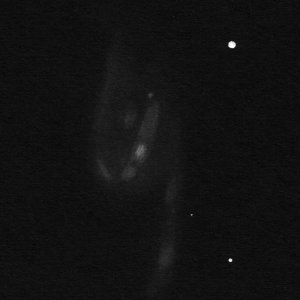
Uwe Glahn, 16",129x-225x, fst 6m5:
bright bar elongated NW-SE, bright core, at the NW and SE end of the bar two brighter spots, longer arm starts SW of the core with two brighter spots, brightest spot at 2/3 in direction N, second brightest spot at the beginning of the arm
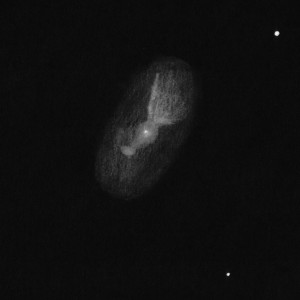
Martin Schoenball, 10",139x, fst 6m3:
Bright galaxy, bright core, it is brightest northwest of the center. In all it has a oval shape at low magnification. At higher magnifi. the part in the norhwest is dominating. The center extends faintly towards southeast und leads to a faint but large knot. Elongation about 3:1 SE-NW.
Matthias Juchert, 12,5", fst 7m0:
Long, very bright central area with 2 obvious spiral arms not winding around the core but extending nearly parallel due north and south. Visually not as asymmetric as on photos.

NGC 4088, 10m3, 5.8' x 2.3', SAB(rs)bc
Distance: approx. 35 MLy
Ursa Major
Uranometria: S. 47 (old), S. 37-right (new)
DSS II (5' x 5')
further information:
SDSS Image
Messier45.com
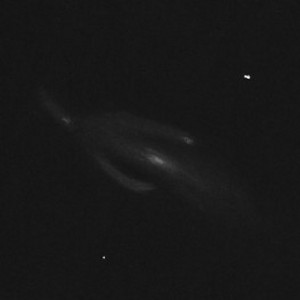
Uwe Glahn, 16", 315x, fst 6m5:
bright, 1:2 NE-SW elongated nucleus within the 3:1 NE-SW elongated galaxy; 2 arms along the galaxy; brightest arm startet at the SE side of the galaxy and runs till till the NE end; second brightest arm is divided by an dark band, starting from SW at the NW side of the galaxy; a third brighter part started seperated from the NE end of the galaxy and is elongated 1:3 NE-SW
Matthias Juchert, 2,5", fst 6m5:
Obvious nebula, medium to small size.
Matthias Juchert, 8", fst 5m8:
The galaxy is easy to find north of the prominent "Y". It is obvious, pretty bright, not quite edge on. The overall shape is long-oval and pretty homogenuous.

NGC 145, 12m7, 1.8' x 1.3', SB(s)dm
Distance: approx. 190 MLy
Cetus
Uranometria: S. 216 (old), S. 101-left/121-left (new)
DSS II (5' x 5')
further information:
Messier45.com
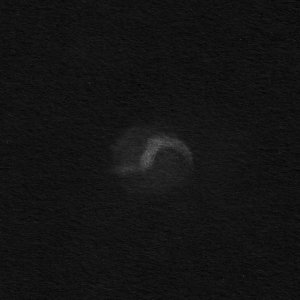
Uwe Glahn, 16", fst 7m2:
brightest arm in the W, bean shape with concave side to the south , second brightest arm in the E, very faint

NGC 4618, 10m6, 4.2' x 3.4', SB(rs)m
Distance: approx. 20 MLy
Canes Venatici
Uranometria: S. 75 (old), S. 37-right (new)
DSS II (5' x 5')
further information:
SDSS Image
Messier45.com
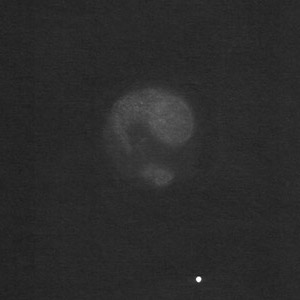
Martin Schoenball, 10", 197x, fst 6m4:
bright galaxy, very odd shape: looks like a curled tadpole, broad main part barely brighter to the middle. A broad arm runs counterclockwise away from eastern main part an gets sharper. A knot lies detached to the south. The whole galaxy is surrounded by a pretty faint, circular halo.

Uwe Glahn, 16", 225x, fst 6m7:
dominating 1:3 NE-SW elongated nucleus with mottled structure; its NE-end has some structure to the N; a 2,5' long arm starts on the N-end of the nucleus; the arm is brighter and thicker to its S-end; brightest HII Region IC 3668 is easy to see; a very faint and stellar region is found 45" E of the nucleus
Matthias Juchert, 10" fst 6m4:
A bright and large galaxy with very special details. In a round-oval halo lies an eccentric, bright core. A spiral arm extends from here in direction of a bright star. The arm has different brightnesses. Brilliant!
Uwe Glahn, 4"", 88x, fst 6m5+:
Small, also
at 88x, 2:3 N-S elongated; the core is inclines NE-SW and shifted north; fainter
in the south.

NGC 7678, 11m8, 2.4' x 1.7', SAB(rs)c I-II
Distance: approx. 160 MLy
Pegasus
Uranometria: S. 169 (old), S. 63-right (new)
DSS II (5' x 5')
further information:
Messier45.com

Uwe Glahn, 16", 200x, fst 7m2:
beautiful Arp-galaxy, in the middle of a triangle of 11-12mag stars, very bright stellar nucleus, galaxy elongated from N-S, dominating spiral arm easy to detect, second faint elongated structure in the W
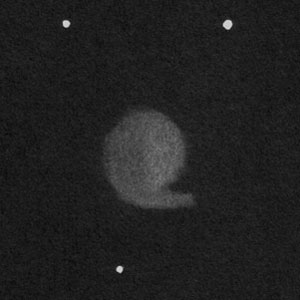
Martin Schoenball, 10", 197x, fst 7m0:
Bright galaxy, a small extension toward west is visible in the south. The galaxy is barely brighter in the middle. The whole western half appears slightly brighter. Little elongated N-S.

NGC 6946, 9m0, 11.6' x 9.9', SAB(rs)cd
Distance: approx. 13 MLy
Cepheus
Uranometria: S. 56 (old), S. 20-left (new)
DSS II (10' x 10')/p>
further information:
Messier45.com

Uwe Glahn, 20x125, fst 6m3:
no spiral arms in the bino
Uwe Glahn, 16", fst 6m3:
galaxy divided into two dominating spiral arms, fainter spiral structure is also visible, many knots in the spirals, bright SSC 6946-1447 is visible with averted vision
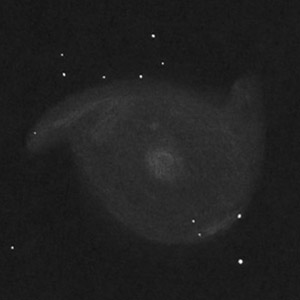
Martin Schoenball, 10", fst 6m3:
Bright galaxy, very large, but low surface brightness. No brightening to the center but shows a broad little brighter core. The galaxy is spiraling with one arm on both sides of the large galaxy body attached, swirling counter-clockwise. There is a brighter area the beginning of the eastern arm, as well as at the inner side of this arm. North of the center is a very faint knot. All in all very low contrasts and many stars embedded.
Matthias Juchert, 2", fst 6m5:
The spiral galaxy is visible even in 7x50 binoculars as a very faint nebula. It is much fainter than the neighboring star cluster NGC 6939.
Matthias Juchert, 12,5", fst 6m5:
Very nice view at low power with NGC 6939. Even at 47,5x some details are visible. The center is not very pronounced. The western spiral arm is visible best with a counter-clockwise winding. One can note the width of the arm but can not split it. The northern arm is only very faint and oddly seems to wind clockwise after a straight part.

NGC 6365, 14m2, 1.0' x 0.5', Sdm
NGC 6365A, 13m9, 1.1' x 0.2', SBcd:
Distance: approx. 390 MLy
Draco
Uranometria: S. 29 (old), S. 11-left/21-right (new)
DSS II (5' x 5')
further information:
SDSS Image
Messier45.com
not observed yet

NGC 4615, 13m1, 1.6' x 0.7', Scd:
Distance: approx. 220 MLy
Coma Berenices
Uranometria: S. 149 (old), S. 71-right/72-left (new)
DSS II (5' x 5')
further information:
Messier45.com
not observed yet